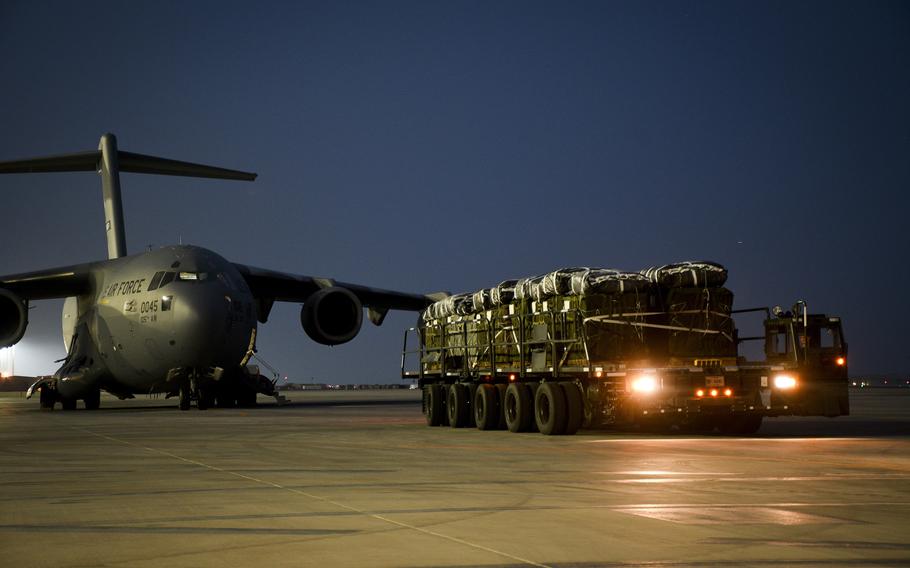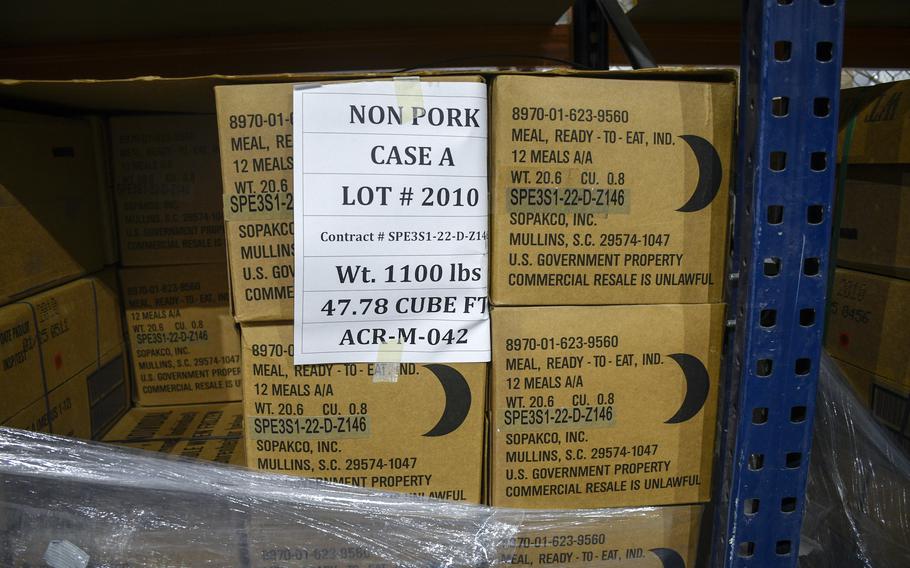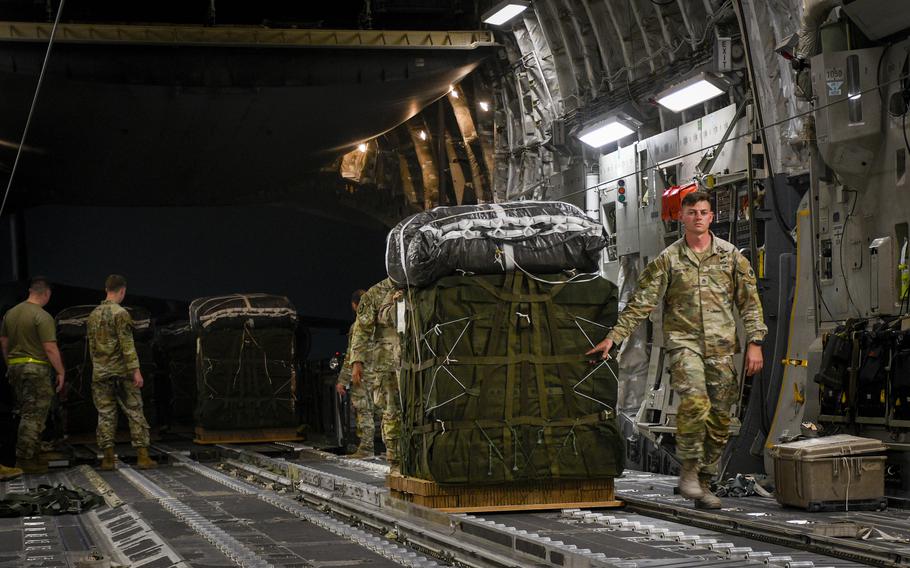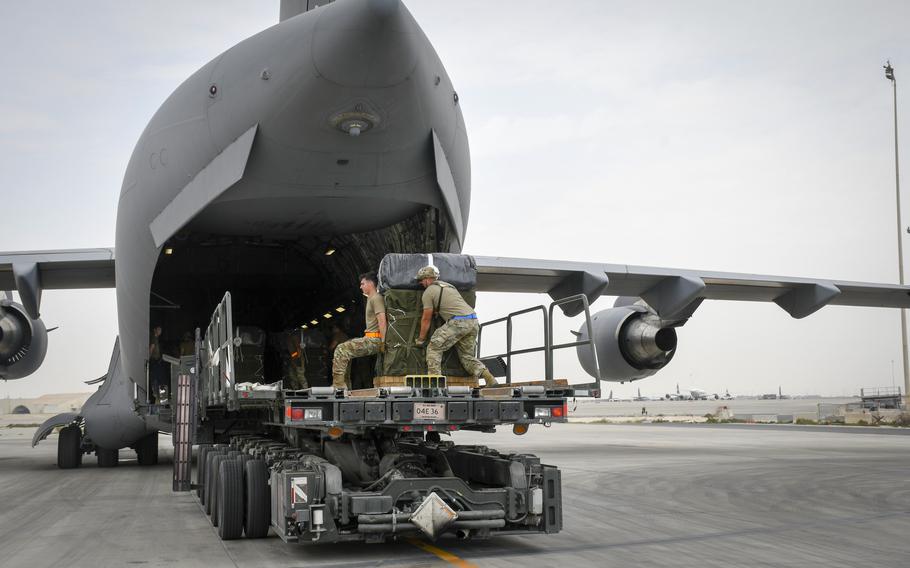
Humanitarian aid for Gaza is loaded onto a U.S. Air Force C-17 Globemaster III on March 16, 2024, at Al Udeid Air Base in Qatar. The pallets of food and water were airdropped into the northern part of the Gaza Strip the following day. (J.P. Lawrence/Stars and Stripes)
AL UDEID AIR BASE, Qatar — Work has been going on around the clock since the beginning of this month at the largest U.S. base in the Middle East as soldiers and airmen scurry to assemble aid pallets for airdrops to Palestinians in the Gaza Strip.
On the Al Udeid flightline Saturday, service members loaded two Air Force C-17 Globemaster III cargo planes with more than 28,800 military rations and 34,500 bottles of water.
The planes took off from the base the following day, on their way to the U.S. military’s 13th airdrop of aid into northern Gaza, a U.S. Central Command statement said Sunday.
Brig. Gen. Sean Davis, head of the Army’s 13th Armored Corps Sustainment Command, said the provision of aid by various means could end up resembling a very different operation — the Berlin Airlift.
For 15 months between June 1948 and September 1949, that operation delivered more than 2.3 million tons of cargo to Berlin residents after the Soviet Union imposed a blockade.
“The entire base has mobilized for this,” Davis said Sunday.
The U.S. and Jordanian air forces have dropped 318,912 meals and 144,000 bottles of water, according to Central Command statements since March 2.
Pallets from Al Udeid are filled with Meals, Ready to Eat rations, which have about 1,300 calories each and include an entree, snacks and a heater.
The rations come from other U.S. bases in the region and do not contain pork, in accordance with Islamic dietary rules, Air Force officials said.

Military rations are stacked up at Al Udeid Air Base in Qatar to be placed onto a U.S. Air Force cargo plane and airdropped into the Gaza Strip. (J.P. Lawrence/Stars and Stripes)
The war that began Oct. 7, after a Hamas terrorist attack killed 1,200 people in Israel, has created an acute crisis for Gaza residents.
Airdrops alone don’t provide sufficient supplies, aid organizations argue. The air routes are part of a larger undertaking that includes a sea route and efforts to send aid by land, which is seen as the fastest, most efficient method, Davis said.
The sea route refers to plans to deliver aid via a temporary pier, which U.S. officials say could provide as many as 2 million meals a day.
The land route, Davis said, could involve the U.S. providing food to contractors who bring the aid into Gaza. Should the sea and land routes ramp up, the air bridge can wind down, he added.
Earlier this month, the U.S., along with nations in the Persian Gulf and Europe, began a surge of aid into Gaza, where almost 2.2 million people are in urgent need of humanitarian relief, according to the United Nations and nonprofit relief groups.
Military food inspectors at the base check the condition of the rations, which are then prepared for airdrop by soldiers with the help of some 80 Air Force volunteers on base.
The pallets of food plus a parachute weigh 1,200 pounds, and the ones carrying water bottles weigh more than a ton. Soldiers attaching parachutes on top of each pallet said they are aware of the damage these pallets could do if the rigging malfunctions.

Army Staff Sgt. Jacob Engstrom of the 165th Quartermaster Company walks a bundle of humanitarian aid onto a U.S. Air Force C-17 Globemaster III on the flightline at Al Udeid Air Base, Qatar, on March 16, 2024. (J.P. Lawrence/Stars and Stripes)
“We do everything in our power to ensure these bundles go down to the ground safely,” said Army Staff Sgt. Jacob Engstrom, a parachute rigger from the 165th Quartermaster Company.
One parachute malfunctioned March 8, killing five Palestinians and wounding several others, CNN reported. A CENTCOM statement said that the errant airdrop wasn’t a U.S. operation.
Soldiers at Al Udeid said they use a different kind of parachute than the one shown in the video of the fatal airdrop.
These low-velocity parachutes are 64 feet in diameter and come down relatively slowly, at 28.4 feet per second or less, Engstrom said. Each pallet also has an inch-thick layer of cardboard to blunt the force of the fall, he said.
The drops are monitored through drone feeds and evaluated for issues with the landing, military officials said. The post-drop assessments and videos show that the pallets are surrounded as soon as they hit the ground, Davis added.
“These people are starving, and they need this food,” he said, showing a photo of a Palestinian girl holding an MRE, a screenshot from a newscast that he had in his wallet.
“It’s an honor to get it to them and alleviate any human suffering that we can.”

Soldiers at Al Udeid Air Base, Qatar, load a U.S. Air Force C-17 Globemaster III with a bundle of humanitarian aid on March 16, 2024. (J.P. Lawrence/Stars and Stripes)